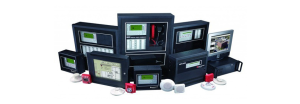Common technologies in fire alarm control panel (FACP)

New FACP fire alarm control panel technologies, such as wireless and smart technology, benefit fire protection companies as well as vendors of these equipment.
For more than half a century, FACP panels have used IDC device indicator circuits to channel alarm and monitoring signals, heat sensors, water level indicators, temperature sensors, and more. To do this, they monitor all aspects of the environment through connected devices. This type of fire panel, called conventional FACP, is still in use today. But it is quickly giving way to another type of FACP designed to assign a unique identifier to each monitored device. One of them uses wireless radio technology and the other uses data-oriented cable technology.
Today, it is common to include multi-criteria sensors in a sensor that provides different types of environmental data. When this approach is analyzed, it allows an intelligent FACP to determine the difference between a real fire and what merely appears to be a fire.
These trends should be of interest to fire protection companies as well as security integrators and sensor vendors. In this article, we discuss common fire alarm control panel technologies to get a clearer picture of the different options available, as well as why these new trends are becoming more popular among safety professionals.
Change from conventional panel to addressable
Companies that sell and service fire alarm systems today are a major part of the equipment that protects against smoke, fire heat, carbon monoxide, and other life-threatening conditions through special devices that connect to a typical FACP. will be
Although conventional FACPs do an adequate job of detecting, notifying, and integrating with a variety of critical building subsystems to further control the fire, they also have limitations. For example, one of the major drawbacks of IDC-based panels is that, under normal circumstances, there is no way to determine exactly what triggered the alarm.
Identifying a specific device is equivalent to knowing the exact location in a facility where a potential fire exists. The only way to do this is to use an addressable FACP, or FACP, which is used by wireless devices. Then, in any case, each device becomes a unique addressable point in a fire alarm system, and before firefighters arrive, they can know exactly where they are going within the facility, even enabling hit the ground
There are other advantages to using addressable technology in safety systems. One of the most important is the wealth of data that many addressable devices can transmit to the FACP, such as the instantaneous sensitivity level of each real-time addressable smoke detector. Activation sequence between sensors. Transmission and analysis of simultaneous sensor readings when multi-criteria detectors are used.
Wireless fire detection in commercial businesses
The incorporation of wireless radio technology into the field of fire detection has been around for decades.
Because of today’s strict fire codes, such as UL864 10th Edition, wireless fire detection has become serious business. While in the past, wireless fire detection was only partially implemented by one or two specialized manufacturers, today the number of manufacturers that go wireless is increasing.
To receive proper listing from a third-party testing service, such as UL, a wireless device such as a smoke detector must also meet the requirements of several sections of NFPA 72, National Fire Alarm and Signal Code, 2016 Edition.
Here are some terms related to FACPs and diagnostic devices used:
A transmitter must register a unique identification number in a wireless sensor so that the wireless FACP can distinguish them from another.
Dry cell batteries are permitted, but must be able to maintain detector or sensor operation for one year before reaching the discharge threshold.
When said battery reaches its discharge threshold, it should still have enough power to transmit wireless surveillance signals, followed by a problem-free response.
The wireless FACP must be able to distinguish between a trouble signal from said transmitter and an alarm, monitoring, tampering, and other signal.
The FACP must be able to clearly identify the affected transmitter and effectively rebroadcast the sound at least once every four hours if it goes out.
If the connection between the dry cell battery in the device transmitter is broken or shorted, the FACP must be able to detect this event. Once the alarm goes off, it must be re-sounded locally at least every four hours to clear the condition.
Wireless signal transmission process
Back in the day, a typical POTS provided all the connections needed to deliver alarm signals to a central or monitoring station. Usually two lines are required, or a POTS line with another form of code-compatible communication, such as cellular or TCP/IP.
Over time, many companies offering POTS service realized that there was more money to be made in cellular communications. Therefore, POTS has reached the point where its reliability is often considered.
“As POTS lines continue to disappear, millions of fire alarm control panels across the country are at risk of not communicating in an emergency,” said Jody Jones-Shand, vice president of marketing for Napco Security Technologies, Amityville, New York. Today’s mobile communicators are an ideal solution for custodial accounts and security companies.
They are givers.
The bottom line is that when it comes to fire detection, there are many things to consider for protection. This is precisely why it is so important to use fire alarm detection panels and devices that are only third-party tested and listed.
دیدگاه خود را با ما در میان بگذارید














